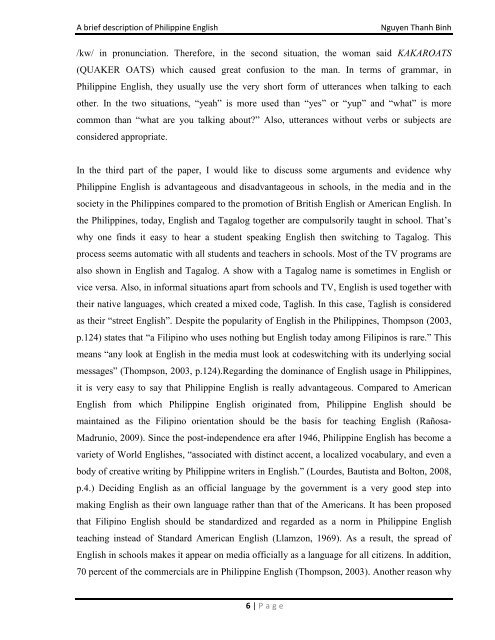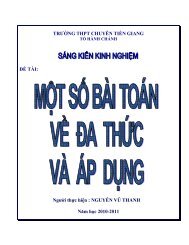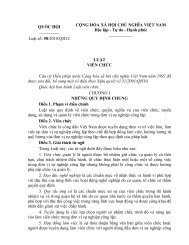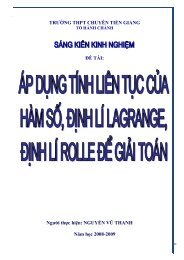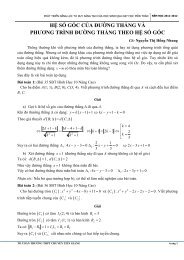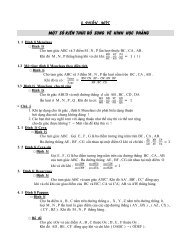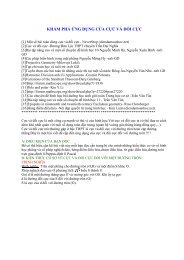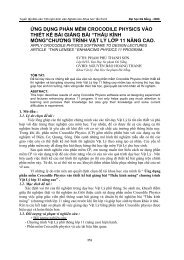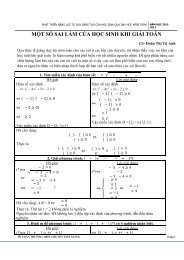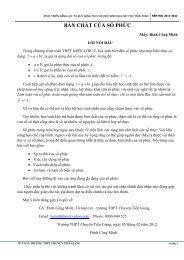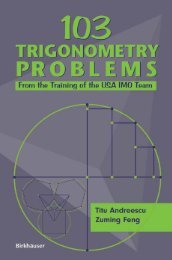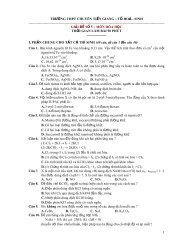A BRIEF DESCRIPTION OF PHILIPPINE ENGLISH
A BRIEF DESCRIPTION OF PHILIPPINE ENGLISH
A BRIEF DESCRIPTION OF PHILIPPINE ENGLISH
Create successful ePaper yourself
Turn your PDF publications into a flip-book with our unique Google optimized e-Paper software.
A brief description of Philippine English Nguyen Thanh Binh<br />
/kw/ in pronunciation. Therefore, in the second situation, the woman said KAKAROATS<br />
(QUAKER OATS) which caused great confusion to the man. In terms of grammar, in<br />
Philippine English, they usually use the very short form of utterances when talking to each<br />
other. In the two situations, “yeah” is more used than “yes” or “yup” and “what” is more<br />
common than “what are you talking about?” Also, utterances without verbs or subjects are<br />
considered appropriate.<br />
In the third part of the paper, I would like to discuss some arguments and evidence why<br />
Philippine English is advantageous and disadvantageous in schools, in the media and in the<br />
society in the Philippines compared to the promotion of British English or American English. In<br />
the Philippines, today, English and Tagalog together are compulsorily taught in school. That‟s<br />
why one finds it easy to hear a student speaking English then switching to Tagalog. This<br />
process seems automatic with all students and teachers in schools. Most of the TV programs are<br />
also shown in English and Tagalog. A show with a Tagalog name is sometimes in English or<br />
vice versa. Also, in informal situations apart from schools and TV, English is used together with<br />
their native languages, which created a mixed code, Taglish. In this case, Taglish is considered<br />
as their “street English”. Despite the popularity of English in the Philippines, Thompson (2003,<br />
p.124) states that “a Filipino who uses nothing but English today among Filipinos is rare.” This<br />
means “any look at English in the media must look at codeswitching with its underlying social<br />
messages” (Thompson, 2003, p.124).Regarding the dominance of English usage in Philippines,<br />
it is very easy to say that Philippine English is really advantageous. Compared to American<br />
English from which Philippine English originated from, Philippine English should be<br />
maintained as the Filipino orientation should be the basis for teaching English (Rañosa-<br />
Madrunio, 2009). Since the post-independence era after 1946, Philippine English has become a<br />
variety of World Englishes, “associated with distinct accent, a localized vocabulary, and even a<br />
body of creative writing by Philippine writers in English.” (Lourdes, Bautista and Bolton, 2008,<br />
p.4.) Deciding English as an official language by the government is a very good step into<br />
making English as their own language rather than that of the Americans. It has been proposed<br />
that Filipino English should be standardized and regarded as a norm in Philippine English<br />
teaching instead of Standard American English (Llamzon, 1969). As a result, the spread of<br />
English in schools makes it appear on media officially as a language for all citizens. In addition,<br />
70 percent of the commercials are in Philippine English (Thompson, 2003). Another reason why<br />
6 | P a g e


